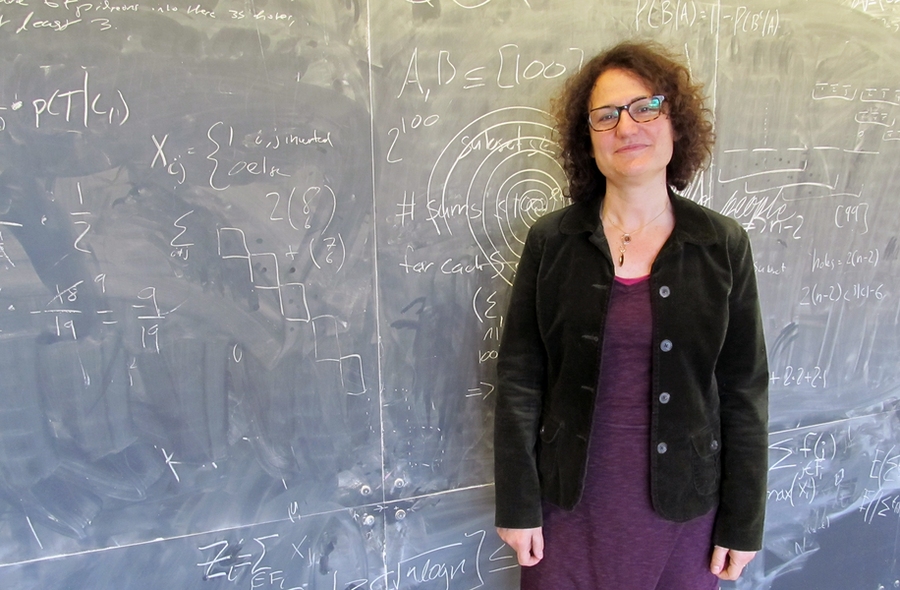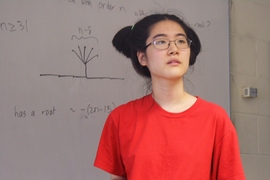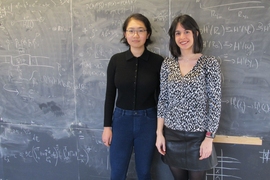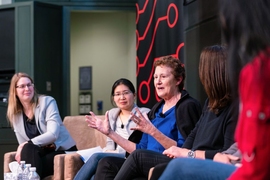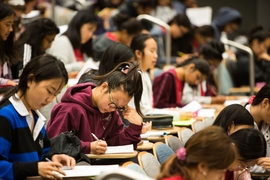In 2008, Gigliola Staffilani, the Abby Rockefeller Mauzé Professor in the Department of Mathematics, and former MIT assistant professor Katrin Wehrheim spearheaded the Celebration of Women in Mathematics at MIT, a two-day event focused on MIT’s role as a leading educator of women mathematicians. Shortly after, Staffilani and Wehrheim founded MIT’s Women in Mathematics, a group of graduate students, postdocs, and faculty dedicated to the professional and personal success of women mathematicians. They also initiated the Weeks Lectures, aptly named after Dorothy Weeks, the first woman to receive a doctorate from the Department of Mathematics in 1930.
Prior to joining MIT in 2002, Staffilani taught on the faculties of Stanford University and Brown University after receiving her PhD from the University of Chicago in 1995. Specializing in dispersive nonlinear partial differential equations, her work in theoretical mathematics investigates tools to analyze complex equations coming from physics for which explicit solutions are not available. Staffilani is an elected member of the American Academy of Arts and Sciences, a fellow of the American Mathematical Society and a Guggenheim fellow. More than 10 years after the 2008 celebration, Staffilani answers questions about the future of women in her field.
Q: What is the status of women in mathematics today?
A: This is a very difficult question to answer because it is really multi-dimensional. From a personal perspective, I can say that there is definitely a larger presence of women in math departments than when I first started at MIT, in particular the number of tenured professors. When I was a graduate student, Stanford, the University of Chicago, and Harvard University had none, Princeton had a couple, and MIT hired the first one shortly after in applied math. The situation now is much, much better. Even Harvard, the last to capitulate, has one female senior professor. And at MIT, we now have four tenured women [Bonnie Berger-Leighton, Ju-Lee Kim, Nike Sun, and Staffilani].
I believe that the presence of women faculty is fundamental to train, attract, and retain more women in the field — it is a chain reaction. But an academic career is just one path. Many fantastic women who are successful undergraduates here at MIT and potentially could become top-caliber professional researchers in mathematics may decide to take very well-paying jobs in industry or exciting startups, and this is great, too.
Q: How have things changed (or not) in terms of gender parity in mathematics, in research, academic, or industry positions?
A: My sense is that, in terms of stipends and grants, women are doing as well as men in academia, at least at MIT. My sense is also that women in academia tend to negotiate less or look less often for outside offers, so it could be that later in their careers, they may start making less compared to male colleagues who are more actively looking to be retained. I do not know what happens in industry, but in many other aspects, women are doing worse — they are not proportionally represented as speakers at conferences and yet they are asked to serve on all sorts of committees and panels because institutions often ask for the presence of at least one woman. And they are disproportionately asked to write letters of recommendation because often institutions ask to have at least a couple of women writers.
Q: What does the future of women in math look like?
A: I am optimistic. I see more women in departments with strong research records who will be able to train other talented women and serve as positive role models. But often, I read articles and blog posts from women who, rightly-so, express discontent with all sorts of implicit biases, sexual harassment, discrimination, and so on. For young women out there, it must be very discouraging. I think it is up to us senior women to convince them that, in spite of all of the potential negatives, being a professional woman mathematician is really fun and rewarding.
Q: Which female mathematician, living or dead, would you most want to have a conversation with and why?
A: I wish I had talked more with Catherine Morawetz when she was alive. In fact, I had received a card from her few months before she passed, and I was planning to go to New York City to see her; but unfortunately, I didn’t make it in time. She was an amazing mathematician; she did most of her research as a research affiliate at NYU while her husband had a professorship. I would have liked to know how she felt about not being recognized for her incredible research until much, much later, when she was finally given a professorship. I would have liked to know if the stress and commitments, which usually take focus and time away from research, may in fact, have helped her research progress. And I would have liked to know how she managed the demands that come from children — if, like for me, their presence actually helped in smoothing out the usual obsession that comes from a brain fully engaged with a hard-to-crack math problem. Most of all, I would have liked to know what she loved about being a mathematician.
[Morawetz SM '46 was a Canadian mathematician who received her master’s degree at MIT, working at the Institute later as a research associate after receiving her doctorate from New York University. She returned to the NYU’s Courant Institute of Mathematical Sciences, where she served as its director. She is acclaimed for her work on partial differential equations regarding fluid dynamics. In 1981, she was the first woman to deliver the American Mathematical Society’s Gibbs Lecture and in 1998, she became the first female mathematician to receive the National Medal of Science.]
